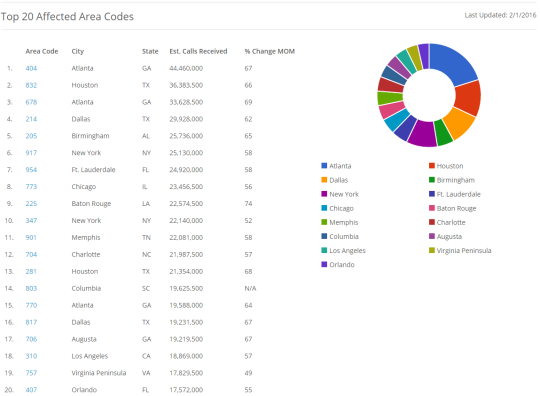The New Year isn’t off to a great start in terms of protecting your phone’s privacy. In January, YouMail’s latest National Robocall Index™ reported an estimated 2.3 billion robocalls were placed to U.S. phones. The data marks a 54.7% month-over-month increase in the number of robocalls received and determines 858 robocalls were placed every second. This roughly triples the number of robocalls received in the past four months and breaks a new monthly record for the nation’s robocall volume.
YouMail’s National Robocall Index™ highlights top robocalling phone numbers, most robocalled cities, and most common types of robocalls in the United States each month.
The Breakdown:
January’s robocall report shows that for the second straight month, Atlanta was by far the most robocalled city in the U.S., with an estimated 99.6 million calls received. Rounding out the “Top 5 Most Robocalled Cities in America” were Chicago (77.9 million), Houston (74.6 million) and New York City (66.3 million).
Atlanta also topped the list for the “40 Most Robocalled Area Codes Per Capita” with 36 calls received per person on average during January in the 404 area code, or more than one robocall per day.

New Robocall Trends:
The Presidential campaign may have generated a noticeable increase in robocalls leading up to the Iowa caucuses and the New Hampshire primary election in January. Robocalls to Iowans rose 46% to 10.2 million calls received in January and robocalls to New Hampshire voters spiked 55% to 6.4 million robocalls received in January.
Leading up to the South Carolina primaries, Charleston, S.C., and Columbia, S.C., each jumped 12 spots on the “Most Robocalled Cities in America” list. Robocalls were up 79% in Charleston to 17.4 million calls in January, while the robocall volume increased by 83% in Columbia to 19.6 million robocalls received in January.
What This Means for You:
A resolution passed by the FCC in June gave the FCC greater authority to fine spammers and spoofers, and it allows telephone carriers to offer robocall-blocking services to customers. However, robocallers can place thousands of calls in seconds from overseas dialers outside of FCC jurisdiction, and many switch phone numbers daily or hourly.
“To really solve a problem, you first need to measure it so you can track progress,” said Alex Quilici, CEO of YouMail. “Our YouMail Robocall Index gives policymakers and everyday Americans a much clearer picture of the enormous scope and rampant growth of this insidious problem.“
If you’re constantly receiving robocalls, to really stop them you need to know which incoming calls are spam and not answer them. You can easily find out which phone numbers belong to common robocallers by using YouMail’s Robocall Index. And for even more protection, use YouMail’s Smart Blocking, which recognizes robocallers and plays them a disconnected tone to give the impression that your phone number is out of service and get you removed from robocaller’s lists. Remember to continue spreading awareness of the growing robocall problem so that your friends and family know which phone numbers to avoid answering. Add the Robocall Index widget to your website for a comprehensive list of top spammers in the U.S. each month.
Find out additional information about the results from January’s Robocall Index in this article posted to PR Newswire.

